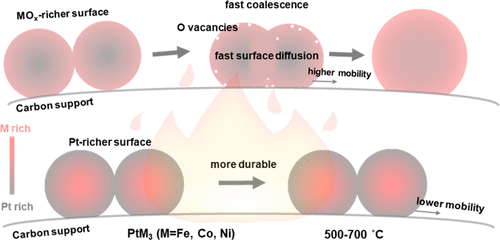当前位置:
X-MOL 学术
›
ACS Catal.
›
论文详情
Our official English website, www.x-mol.net, welcomes your
feedback! (Note: you will need to create a separate account there.)
Revealing the Role of Surface Composition on the Particle Mobility and Coalescence of Carbon-Supported Pt Alloy Fuel Cell Catalysts by In Situ Heating (S)TEM
ACS Catalysis ( IF 11.3 ) Pub Date : 2020-06-04 , DOI: 10.1021/acscatal.0c01765 Xiaozhang Yao 1 , Yinping Wei 1 , Zhongxiang Wang 1 , Lin Gan 1
ACS Catalysis ( IF 11.3 ) Pub Date : 2020-06-04 , DOI: 10.1021/acscatal.0c01765 Xiaozhang Yao 1 , Yinping Wei 1 , Zhongxiang Wang 1 , Lin Gan 1
Affiliation

|
Thermal annealing is an indispensable process during the preparation and structural ordering of Pt alloy fuel cell catalysts, which exhibit superior electrocatalytic activities as compared to Pt catalysts and thus enable decreased Pt usage. However, thermal annealing usually induces detrimental particle sintering, which greatly offsets the performance enhancement. Although the mechanisms of particle sintering of monometallic Pt catalysts have been well studied, knowledge on the key factors controlling the particle sintering of Pt alloy catalysts is still very poor. Herein, we perform in situ heating (scanning) transmission electron microscopy of carbon-supported low-Pt alloy catalysts (PtFe3, PtCo3, and PtNi3) and reveal that the surface composition plays a key role in both the particle mobility and the coalescence process of the supported low-Pt nanoparticles (NPs) under high temperatures. A surface enrichment of the less-noble transition metals not only induces a faster particle coalescence due to enhanced surface diffusion, but also causes a higher mobility of the NPs on the carbon support due to a strong chemical interaction between the less-noble transition metals and the carbon support. In contrast, the Pt richer surface results in a lower NP mobility as well as slower surface diffusion across contact NPs, which contributes to a higher antisintering capability. Our results suggest that controlling the surface composition, for example, by engineering the elemental growth kinetics during nanoparticle synthesis, is critical for controlling the particle sintering of Pt alloy catalysts during thermal annealing.
中文翻译:

通过原位加热(S)TEM揭示表面组成对碳载Pt合金燃料电池催化剂的颗粒迁移和聚结的作用
在Pt合金燃料电池催化剂的制备和结构订购过程中,热退火是必不可少的过程,与Pt催化剂相比,热退火具有出色的电催化活性,因此可以减少Pt的使用。然而,热退火通常引起有害的颗粒烧结,这大大抵消了性能的提高。尽管已经对单金属Pt催化剂的颗粒烧结机理进行了充分的研究,但是对于控制Pt合金催化剂的颗粒烧结的关键因素的知识仍然非常匮乏。在此,我们对碳负载的低铂合金催化剂(PtFe 3,PtCo 3和PtNi 3进行原位加热(扫描)透射电子显微镜)并揭示了表面成分在高温下负载的低Pt纳米颗粒(NP)的颗粒迁移率和聚结过程中都起着关键作用。较稀有过渡金属的表面富集不仅会由于增强的表面扩散而导致更快的颗粒聚结,而且由于较稀有过渡金属与碳载体。相反,富Pt的表面导致较低的NP迁移率以及跨接触NP的较慢的表面扩散,这有助于提高抗烧结能力。我们的结果表明,例如通过控制纳米颗粒合成过程中的元素生长动力学,可以控制表面组成,
更新日期:2020-07-02
中文翻译:

通过原位加热(S)TEM揭示表面组成对碳载Pt合金燃料电池催化剂的颗粒迁移和聚结的作用
在Pt合金燃料电池催化剂的制备和结构订购过程中,热退火是必不可少的过程,与Pt催化剂相比,热退火具有出色的电催化活性,因此可以减少Pt的使用。然而,热退火通常引起有害的颗粒烧结,这大大抵消了性能的提高。尽管已经对单金属Pt催化剂的颗粒烧结机理进行了充分的研究,但是对于控制Pt合金催化剂的颗粒烧结的关键因素的知识仍然非常匮乏。在此,我们对碳负载的低铂合金催化剂(PtFe 3,PtCo 3和PtNi 3进行原位加热(扫描)透射电子显微镜)并揭示了表面成分在高温下负载的低Pt纳米颗粒(NP)的颗粒迁移率和聚结过程中都起着关键作用。较稀有过渡金属的表面富集不仅会由于增强的表面扩散而导致更快的颗粒聚结,而且由于较稀有过渡金属与碳载体。相反,富Pt的表面导致较低的NP迁移率以及跨接触NP的较慢的表面扩散,这有助于提高抗烧结能力。我们的结果表明,例如通过控制纳米颗粒合成过程中的元素生长动力学,可以控制表面组成,











































 京公网安备 11010802027423号
京公网安备 11010802027423号